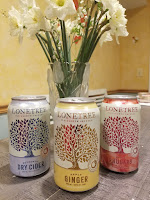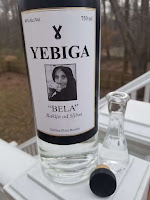
This is a big month for Virginia Cider. Last week the
American Cider Association (ACA) announced the launch of the
Virginia Cider Trail where users of the app can win prizes and receive discounts at participating cider houses. And it just happened that this summer I have already visited four of these establishments. And I believe I was the first to officially check-in using the Virginia Cider Trail app at Sage Bird Ciderworks and Ciders from Mars.

In addition, our partner site at
BevFluence has opened brand registration today for their
Cider: New Perspectives on Cider, Perry, and Brandy campaign. The cider, perry, and brandy products will be presented to a combination of industry experts, mixologists, bartenders, creators, bloggers, writers, and other media – and across the craft beverage landscape. This will generate new perspectives about cider, perry, and apple brandy from creators who range from cider novices to experts. I also plan on taking the ACA's Certified Cider Professional (CCP) exam during this campaign and using the ciders with my training guide. Brands and content creators can register
here for the BevFluence campaign or learn more about the CCP
here.
Lost Boy Cider is an urban cidery in Alexandria and sources its fruit from various orchards in the Shenandoah Valley. In early June they hosted one of four sessions on the
Virginia Cider Road Show presented by the ACA. After a brief overview of Lost Boy by cidermaker Dave, the ACA's Jennie Dorsey provided a history of cider, a history of cider in North America, and then the history of cider in Virginia. She then provided a brief overview of Virginia's three most important apple varieties: Newton (Albemarle) Pippin, Hewes VA Crab, and Harrison. She finished by discussing the ACA's Apple classes (bittersweet, bittersharp, sweet, & sharp); ACA Cider Families (cider, perry, fruit cider, botanical cider, & dessert ciders); cider cocktails; and cider-food pairings. Yes, a boatload of information was packed within each session. We finished with a food and cider pairing featuring cheeses from Cheestique. I think the Barrel-Aged cider paired with the Appalachian cheese, dried pear, and balsamic vinegar was my favorite -- very complimentary.
 Castle Hill Cider
Castle Hill Cider is located east of Charlottesville in Keswick and has an interesting history regarding the propagation of cider apples. As stated on their website:
Colonel Thomas Walker, the original owner of Castle Hill Estate, was the first to bring Newtown Pippin apple scions to Central Virginia following his return from the Battle of Brandywine in 1777. The variety was planted at Castle Hill and became known as the Albemarle Pippin apple.

And as most Virginia cider lovers know, the Albemarle Pippin is still one of the signature Virginia apple varieties and was even exported to England throughout the 1800s. Castle Hill Cider was founded in 2020 and the estate is planted with 6,500 trees featuring more than 30 apple varieties including Albemarle Pippin, Black Twig, Harrison, Burford Red Fresh, GoldRush, Dabinett, Hewes Crab, and Wickson Crab. The ciders are bottled in either 750ml or 375ml bottles and range from sweet to dry.
During our visit, we choose a Classic flight and a Barrel aged flight. The majority of the group preferred the Terrestrial 2020 where the tannins and slight RS are balanced. It's also an interesting blend that includes Black Twig, Winesap, and Ashmead's Kernel. Personally, I preferred the funky, dry, and naturally fermented in quevri Levity 2020. Is this the only American cider fermented and aged in Georgian quevri?
For the barrel-aged ciders, the Hewes Pommeau Reserve is fascinating with complexity created by four years of aging in Woodford Reserve barrels and Keswick Winery wine puncheons. I also enjoyed the Silver Bough where Dabinett and Golden Hornet ciders were aged over a year in rum barrels.
 Sage Bird Ciderworks
Sage Bird Ciderworks is located in downtown Harrisonburg and opened a couple years ago after the persistently hard work of Zach and Amberlee Carlson. This is the first cidery in the home of the Dukes and they offer an excellent array of various styles. I settled on a flight of five ciders - slightly more than the paddle size. The clear favorite was the
Dry River Reserve -- their flagship brut cider made from a blend of Virginia-grown apples. The
Peaches For Me fits perfectly into the upcoming BevFluence campaign since the cider was aged in used apple brandy barrels. The oak treatment is noticeable -- providing a peaches and cream feel with a boost of apple flavors. Finally, an interesting geographic cider is their
Stay Gold, a dry cider inspired by West Virginia's official state fruit, the famed Golden Delicious apple.
 Ciders from Mars
Ciders from Mars is located about 30 miles south in downtown Stanton across the street from both
Ox Eye Vineyards and
Redbeard Brewing Company. So no excuses for not visiting. The cidery was founded by Virginia natives and science-minded Nikki West and Jeremy Wimpey. And Nikki improved her cidermaking through courses at the
Cider Institute of North America -> a partner of the American Cider Association. Over a burger from
1Tribe Farm, I sampled six ciders through a standard flight. The
Helles Dry is a solid representation of a brut cider and on the other side of the spectrum, the
Pink Oceans was interesting with a subtle strawberry profile. However, the most impressive cider was easily the
Liquid Gang, made from foraged apples and fermented using native yeast. The tannic structure mimics biting into an apple. Could be my favorite cider made in Virginia and is on par with the excellent cider from New York's
Aaron Burr Cidery.
 Are you familiar with the main principles of Regenerative Farming? Grgich Hills Estate has been a leader in this innovation, first by farming organically for the past two decades, then biodynamically, and finally regenerative farming as stipulated by Regenerative Organic Certified (ROC) since 2019.
Are you familiar with the main principles of Regenerative Farming? Grgich Hills Estate has been a leader in this innovation, first by farming organically for the past two decades, then biodynamically, and finally regenerative farming as stipulated by Regenerative Organic Certified (ROC) since 2019.  Winemaker and Vice President of Vineyards & Production Ivo Jeramaz and his son Luke provided an overview of this process during a BevFluence® organized tour of one of the Grgich Hills Estate's American Canyon vineyards. Here they farm 121.5 acres at cooler temperatures and stronger winds than in Napa Valley. Over a crescendo of songbirds, ducks, geese, and guinea fowl; Ivo and Luke described how Grgich Hills implements five principles of Regenerative Farming leading to a vibrant nature preserve, productive grapes, reduced costs, and satisfied employees. Check back later for multiple posts on these chemical free principles, but here are the main features:
Winemaker and Vice President of Vineyards & Production Ivo Jeramaz and his son Luke provided an overview of this process during a BevFluence® organized tour of one of the Grgich Hills Estate's American Canyon vineyards. Here they farm 121.5 acres at cooler temperatures and stronger winds than in Napa Valley. Over a crescendo of songbirds, ducks, geese, and guinea fowl; Ivo and Luke described how Grgich Hills implements five principles of Regenerative Farming leading to a vibrant nature preserve, productive grapes, reduced costs, and satisfied employees. Check back later for multiple posts on these chemical free principles, but here are the main features: Grgich Hills also provided a fantastic library tasting of their iconic wines -- after a refreshing glass of their 2021 Essence Estate Sauvignon Blanc ($55). This saline driven refreshing wine offers white grapefruit and stone fruit and is made from practically a 50-50 blend of American Canyon and Carneros grapes. The 2016 Estate Napa Valley Chardonnay still carries similar acidity and minerality with floral and sweet apple and pear notes.
Grgich Hills also provided a fantastic library tasting of their iconic wines -- after a refreshing glass of their 2021 Essence Estate Sauvignon Blanc ($55). This saline driven refreshing wine offers white grapefruit and stone fruit and is made from practically a 50-50 blend of American Canyon and Carneros grapes. The 2016 Estate Napa Valley Chardonnay still carries similar acidity and minerality with floral and sweet apple and pear notes.  Moving to red library wines, we started with the 2018 Estate Napa Valley Merlot which is a blend from three vineyards - the cooler American Canyon and Carneros vineyards and the warmer Yountville vineyard. Expect savory red fruit, some mint, structure and a balanced acidic - but polished finish. We had the pleasure to sip their 2014 Estate Napa Valley Cabernet Sauvignon and compare it to their 2007 Estate Napa Valley Cabernet Sauvignon. The 2014 starts with a wonderful mouthfeel of black fruit and juicy structured tannins. Whereas the 2007 is lighter, it is still vibrant with noticeable tannins mingling with ripe raspberries. The final wine was the 2013 Estate Napa Valley Miljenko's Old Vine Zinfandel sourced from 135-year-old vines grown in Calistoga. Think of savory black fruit dusted with black pepper finishing with juicy tannins.
Moving to red library wines, we started with the 2018 Estate Napa Valley Merlot which is a blend from three vineyards - the cooler American Canyon and Carneros vineyards and the warmer Yountville vineyard. Expect savory red fruit, some mint, structure and a balanced acidic - but polished finish. We had the pleasure to sip their 2014 Estate Napa Valley Cabernet Sauvignon and compare it to their 2007 Estate Napa Valley Cabernet Sauvignon. The 2014 starts with a wonderful mouthfeel of black fruit and juicy structured tannins. Whereas the 2007 is lighter, it is still vibrant with noticeable tannins mingling with ripe raspberries. The final wine was the 2013 Estate Napa Valley Miljenko's Old Vine Zinfandel sourced from 135-year-old vines grown in Calistoga. Think of savory black fruit dusted with black pepper finishing with juicy tannins. 






































